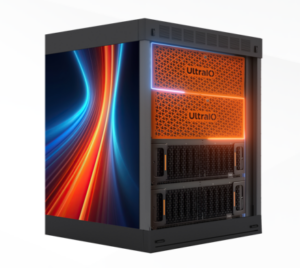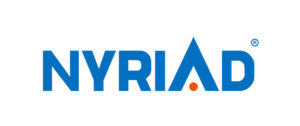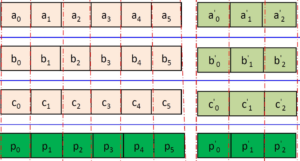
Nyriad Makes GPU-Powered Storage Array Available as a Service

Organizations that need to write a large amount of data to disk in a short amount of time will be pleased to hear they can now get a subscription to one of Nyriad’s UltraIO storage arrays, which are block storage devices that utilize a GPU to accelerate writes.
Nyriad is unique among storage array providers in that it relies on GPUs to provide an accelerated storage environment. The Austin, Texas company recognized that CPUs in modern storage arrays are overloaded in trying to serve both reads and writes, in addition to executing all of the other storage management tasks (compression, de-duplication, replication, etc.) that users demand.
To alleviate that burden, Nyriad designed its UltraIO storage array architecture to use a GPU to offload two tasks from the CPU: write operations to the disk, and erasure encoding used across the HDDs at the block level.
“We use GPUs for the write path, separate from the reads, and we use CPUs for the reads and the other data sources,” says Andrew Russell, Nyriad’s chief revenue officer. “This allows us to get a whole lot more bandwidth, especially on the write side of things, or the ingest side of things, with the array.”
Yesterday the company announced that its arrays can now be obtained through subscriptions. Instead of requiring customers to buy the arrays outright, Nyriad will essentially rent customers the capacity they need on a 12- to 60-month basis.
With UltraIO-as-a-Service, the array will be located on premise or in a managed service provider of the customers’ choosing. The customer retains responsibility for managing the arrays, while Nyriad technically owns the enclosures.
On a three-year contract, the premium for the subscription offering compared to an outright purchase plus support is about 15%, Russell says. That’s quite a bit less than competing solutions that carry a 50% to 100% premium, he says.
“What we’re doing is delivering a cloud-like solution in terms of ease of use and simplicity, but delivering it to them on promise,” he says.
Nyriad started life as a New Zealand company developing storage solutions on behalf of the New Zealand government for the Square Kilometre Array project that’s currently being developed in South Africa and Australia. The SKA project, which is expected to go online in 2027, will generate data at the rate of 2 petabytes per day, which necessitated a faster way to collect data, but without compromising reliability.
When the New Zealand government backed out of the SKA project, Nyriad pivoted to serving commercial sectors. From the Texas tech hub of Austin, the company sells its software-defined storage architecture, leaving the hardware component to its reseller partners. Nyriad first launched its UltraIO arrays about year ago, and so far has found the market receptive to GPU-accelerated storage, particularly in high performance computing (HPC), healthcare imaging, and media markets, among others.
Prior to the launch of UltraIO-as-a-Service, the company had two main offerings: the H1000 and H2000. The two arrays provide up to 1.6PB and 3.3PB of usable capacity, respectively. The company uses industry standard components throughout, including standard HDDs as opposed to solid state drives.
Thanks to the GPUs, storage throughput on its arrays can hit 20GB per second for combined read and write workloads. The company provides core block storage, while the distributed file systems, such as Lustre, BeeGFS, or IBM Spectrum Scale–or object storage systems if needed–are provided by customers or by the partner.
The GPUs are also used for erasure encoding, which provides Nyriad customers a boost in reliability. While erasure encoding is typically used at the file system or the object storage level, Nyriad developed its own erasure encoding technology to apply directly to its block storage. Thanks to the GPUs, the erasure encoding can provide full data parity with a much smaller hit on storage space compared to block array providers that use traditional RAID.
“We get roughly 92% usable storage from every portion of the block,” Russell tells Datanami. “A typical RAIDed array will get anywhere from 50% in the worst case, if it is doing a one-for-one. But typically it will be somewhere in the low 70% overall efficiency ratio in terms of the usable to raw.”
Using erasure encoding at the block storage level provides another benefit for UltraIO arrays, the company says: Less impact on the CPU and the network.
“One of the problems with doing erasure code at the file level is it’s so computationally heavy,” says Adam Roberts, Nyriad’s field CTO and head of product. “When you get to the really small pieces of data, you overcome the file system’s ability to do the erasure code, and they’ll take small files and they’ll triple mirror them…And that’s really, really inefficient.
“So what we do? We do erasure code at a block level,” he continues. “We utilize the GPU to build those erasure codes, and as a result, everything we do is being done at a block level. So we have none of this triple mirror for some files, erasure code for others.”
Erasure coding conducted at the file level also slows the local network, since erasure codes need to be read from all the stripes in all the different enclosures to rebuild data after drives go bad.
“If it’s 10 enclosures, that’s a 10X hit on the network,” Roberts says. “And we remove all that by doing it down in the array.”
The erasure coding is solid enough that Nyriad can lose up to 20 of the 204 HDDs across two UltraIO arrays and not lose any data, the company says.
For more info, check out its website at www.nyriad.io.
Related Items:
Object and File Storage Have Merged, But Product Differences Remain, Gartner Says
Fast Object Storage: Meeting the Demands of Modern Data
Why Object Storage Is the Answer to AI’s Biggest Challenge
[wpsr_share_icons icons="twitter,facebook,linkedin,reddit,email" icon_size="40px" icon_bg_color="" icon_shape="circle" hover_effect="opacity" sm_screen_width="768" lg_screen_action="show" sm_screen_action="show" page_url="https://www.bigdatawire.com/2023/10/19/nyriad-makes-gpu-powered-storage-array-available-as-a-service/" page_title="Nyriad Makes GPU-Powered Storage Array Available as a Service" page_excerpt="Organizations that need to write a large amount of data to disk in a short amount of time will be pleased to hear they can now get a subscription to one of Nyriad’s UltraIO storage arrays, which are block storage devices that utilize a GPU to accelerate writes. Read more…
" share_counter=""]



























